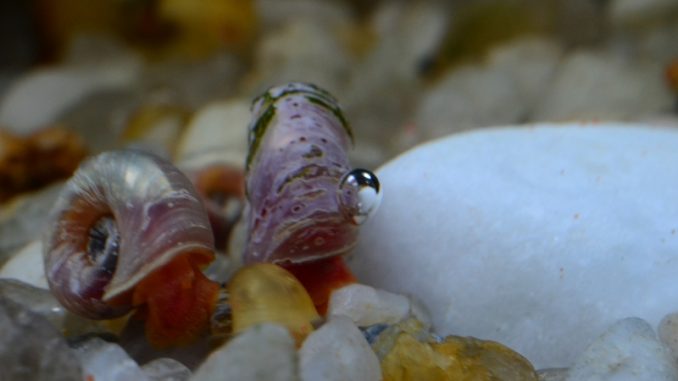
Have you ever wondered what do fish tank snails eat? Fish tank snails come in a variety of types and each type has its own dietary preferences. It can be difficult to determine the best food for your pet snail, but it’s important to know their nutritional needs if you want them to thrive in your aquarium. In this article, we’ll explore different types of snails, what they eat and how to care for them properly. So let’s dive into our discussion on do fish tank snails eat.
Table of Contents:
Types of Snails
Freshwater Snails:
Freshwater snails are a popular choice for fish tanks due to their small size and attractive colors. They come in a variety of shapes, sizes, and colors ranging from browns to blues. These snails can be found in many areas around the world including rivers, lakes, ponds, and streams. Some common types of freshwater snails include Ramshorn Snail, Mystery Snail, Apple Snail, Malaysian Trumpet Snail (MTS), Ivory Snail and Rabbit snail.
Saltwater Snails:
Saltwater snails are another type of aquarium snail that is becoming increasingly popular with hobbyists as they provide an interesting addition to any tank setup. These invertebrates can be found in oceans all over the world and come in various shapes such as spiral shells or conical shells. Common saltwater species include Astraea Conehead snail (also known as Turban snail), Cerith snail , Nassarius Vibex snail , Margarita snail , Nerite Zebra shellsnail , Trochus Maculatus Hermit crab .
What Do Fish Tank Snails Eat?
Fish tank snails are an interesting addition to any aquarium. They come in a variety of shapes, sizes, and colors, and can be quite entertaining to watch as they explore their environment. But what do fish tank snails eat?
Algae and Plant Matter:
Algae is the primary food source for most types of freshwater snails. They will graze on algae that grows on rocks, plants, decorations, or even the glass walls of your aquarium. Some species may also feed on soft plant matter such as decaying leaves or stems from live aquatic plants.
Leftover Food and Decomposing Organic Matter:
Snails will also scavenge for leftover food particles that have sunken to the bottom of your tank or decomposing organic matter like dead insects or worms. If you don’t want them eating all your fish’s food then it’s best to remove uneaten food after feeding time has passed so they won’t get too much nutrition from it.
Commercial Fish Food Pellets or Flakes:
While many people believe that snails only eat algae, some species can actually benefit from being fed commercial fish food pellets or flakes if there isn’t enough natural algae in their environment. This type of diet should be supplemented with other sources such as fresh vegetables like cucumber slices which can provide additional nutrients for your snail’s health and wellbeing.
To ensure that your pet snail is getting enough nutrition from its diet, make sure you are providing a variety of foods including both plant-based items (algae) as well as protein-rich items (commercial fish foods). Additionally, keep an eye out for signs of malnutrition such as pale coloration which could indicate a lack of essential vitamins and minerals in their diet.
Care for Fish Tank Snails
Water Quality and Temperature Requirements:
It is important to maintain the water quality of your fish tank in order for your snails to stay healthy. The pH level should be between 6.5 and 8, with a temperature range of 68-86°F (20-30°C). Make sure you regularly check the ammonia, nitrite, and nitrate levels as well as the hardness of the water.
Appropriate Tank Size and Setup:
Snails need plenty of space to move around in their tank. A 10 gallon aquarium is ideal for a single snail or two small species; larger tanks are needed if you plan on keeping more than one type of snail. Be sure to provide plenty of hiding places such as rocks or driftwood so they can feel secure in their environment. Also make sure there is adequate filtration and aeration since snails require oxygenated water just like fish do.
Snails are scavengers that feed on algae, plant matter, leftover food particles, decaying organic matter, commercial fish food pellets or flakes – whatever they can find. Feed them once every day or two with a pinch of food that will sink quickly to the bottom so it is easily accessible for them. If you notice uneaten food after several hours then reduce how much you give them next time as too much can cause an imbalance in their tank’s chemistry which could lead to health problems down the line.
Conclusion
In conclusion, do fish tank snails eat? Yes, they do. Fish tank snails are a great addition to any aquarium and can provide a lot of benefits. They are easy to care for and will help keep your aquarium clean. There are many types of snails that you can choose from, so make sure to research what type is best for your particular setup. With the right care and food, your fish tank snails will thrive in their new home.
Fish tank snails are an essential part of any aquarium, but they require special care to stay healthy. Without the right food and environment, these creatures can become sick or die. To ensure that your fish tank snails get the nutrition they need, it’s important to feed them a variety of foods like algae wafers, blanched vegetables, shrimp pellets and other nutritious treats. With proper diet and habitat maintenance you can create a thriving aquatic ecosystem for both your pet fish and their snail companions!

Be the first to comment